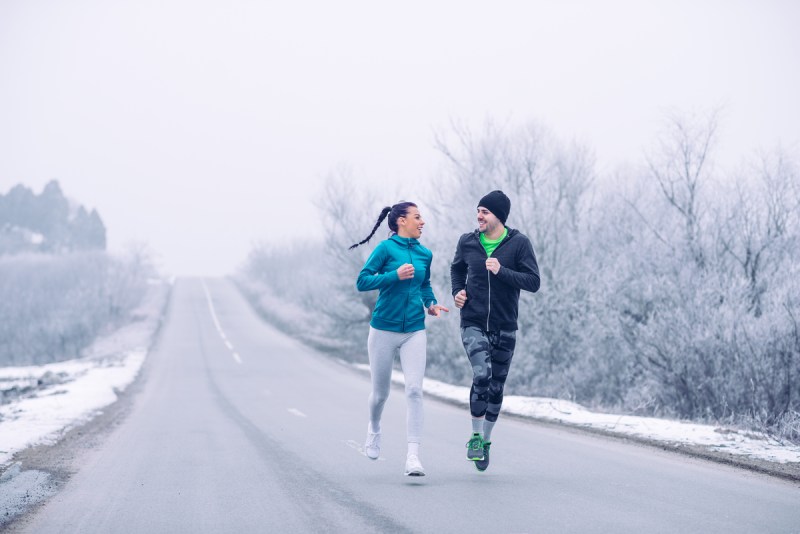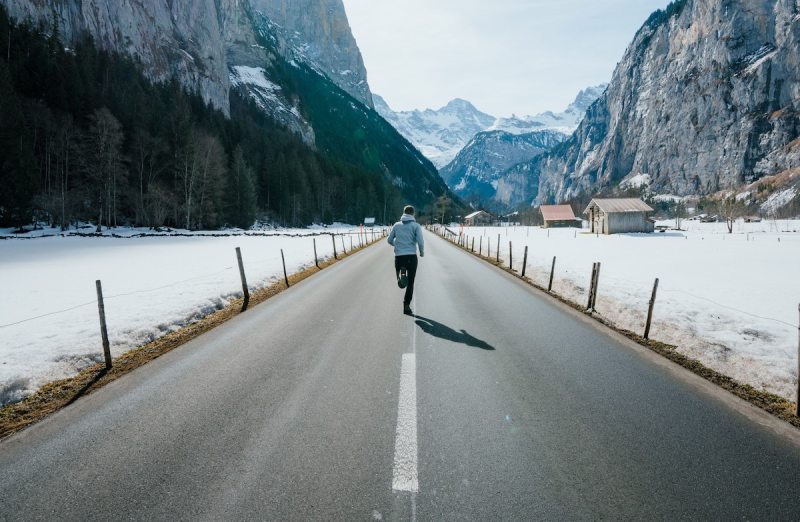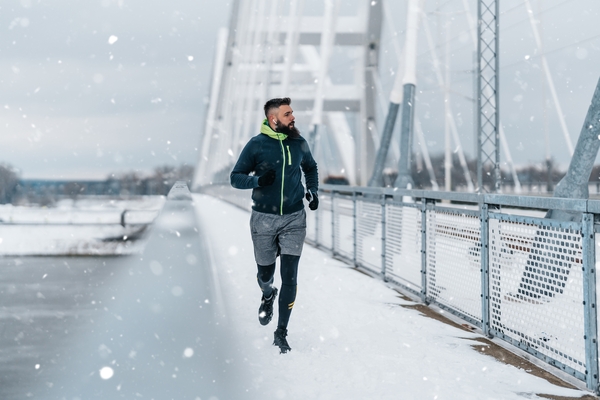
As winter sets in and temperatures begin to plummet, many dedicated runners refuse to let the chill keep them inside. If you prefer to run outside rather than on the treadmill, you don’t need to let the cold weather stop you. Winter running can be invigorating, but it’s important to make sure you’re prepared before you hit the pavement. The proper running gear is essential for protecting yourself against the cold, wind, and possible rain and snow.
Many people actually dress too warm when heading out on a cold-weather run and end up being uncomfortable. It’s recommended you dress for weather that is 10 to 15 degrees warmer than the actual temperature when getting ready to run outside. This allows your body to adjust to the temperature without overheating. Here’s an overview of what you should wear when running outside in the wintertime.

Start with a warm base layer
The foundation of your winter running outfit should start with a moisture-wicking base layer. This layer should include clothing that is made up of a lightweight, breathable fabric that will effectively pull the sweat away from your skin. This prevents you from feeling damp or chilled during your exercise. Popular materials include merino wool, synthetic blends, or moisture-wicking polyester. Cotton is the worst material to choose for your base layer as it is especially slow to dry.
A good base layer in the wintertime includes a long-sleeved shirt and thermal tights. If it is very cold, make sure to tuck your shirt into your tights for extra protection against the wind. If the temperature is not yet below freezing, however, then a T-shirt or tank top may be more comfortable as a base layer.

Pants
If it’s not too cold, you may choose to only wear thermal tights or leggings when you head out on your run. If the temperature is in the 40s or 50s, then you may even want to forego the longer pants and wear mid-length tights or running shorts.
On the other hand, if it is well below freezing, you may want to layer up by adding a second pair of running tights over top of your base layer. Other options include track pants, sweatpants, or joggers.

Running jacket
Over your base layer, you will want to add an insulating layer to trap body heat and shield against the cold. Fleece-lined or thermal jackets and vests are both great choices to keep the heat in during your run. You may want to look for running gear with ventilation options, such as zippered vents, to regulate your body temperature as you begin to heat up.
Additionally, you may want to invest in a windproof and waterproof jacket to wear in case of inclement weather. A lightweight, breathable jacket made of materials like Gore-Tex will help you stay dry without sacrificing your comfort or mobility.

Socks and shoes
One of the most frustrating results of winter running is cold feet. Make sure you choose a pair of moisture-wicking socks made from materials like merino wool to keep your feet dry and warm. It’s a good idea to wear thicker socks than usual, but make sure they are snug on your feet to prevent blisters.
When choosing winter running shoes, you want to find a pair of sneakers with good traction to easily navigate icy or snowy surfaces. Some brands offer winter-specific running shoes that come with features like additional insulation and water-resistant uppers. If you live in an area that is prone to icy conditions, you may even want to invest in a traction device to adhere to your shoes.

Accessories
Make sure your hands are covered, and invest in a good pair of mittens or gloves. Mittens will provide more warmth as they allow your fingers to stay together and share body heat, although most runners find gloves more functional. Buying a pair of gloves with touchscreen compatibility allows you to use your phone or smartwatch without exposing your hands to the cold.
You may also want to invest in warm headwear and a neck gaiter. A good amount of body heat escapes through the head, so adding a moisture-wicking thermal hat can make all the difference when it comes to staying warm. A neck gaiter or scarf is also a great addition to keep your neck shielded from the biting cold.

Additional items to bring along
Just because it’s cold, it doesn’t mean you don’t need to stay hydrated. Bringing water along on your run is a good idea, especially if you’re covering long distances. You can purchase easy-to-grip water bottles or invest in a running vest for hands-free hydration.
Another good item to bring along on longer runs is some sort of fuel for your body. Energy gel packets and protein bars are popular choices for quick bites on the go.

Be careful when running in cold weather
Winter running can be both rewarding and refreshing, but it’s essential to ensure you stay safe. It tends to get darker earlier in the wintertime, so wear reflective gear and stay on well-lit roads when running in the dark. Otherwise, embrace the chill, stay healthy, and enjoy the unique experience that is cold-weather running.



